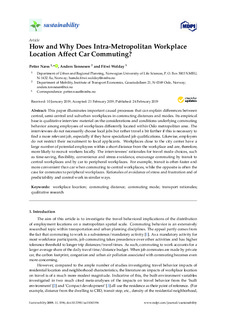| dc.contributor.author | Næss, Petter | |
| dc.contributor.author | Tønnesen, Anders | |
| dc.contributor.author | Wolday, Fitwi | |
| dc.coverage.spatial | Norway | nb_NO |
| dc.date.accessioned | 2019-12-17T13:42:28Z | |
| dc.date.available | 2019-12-17T13:42:28Z | |
| dc.date.created | 2019-02-21T13:15:16Z | |
| dc.date.issued | 2019-02-24 | |
| dc.identifier.citation | Sustainability. 2019, 11(4), 1196 | nb_NO |
| dc.identifier.issn | 2071-1050 | |
| dc.identifier.uri | http://hdl.handle.net/11250/2633709 | |
| dc.description.abstract | This paper illuminates important causal processes that can explain differences between central, semi-central and suburban workplaces in commuting distances and modes. Its empirical base is qualitative interview material on the considerations and conditions underlying commuting behavior among employees of workplaces differently located within Oslo metropolitan area. The interviewees do not necessarily choose local jobs but rather travel a bit farther if this is necessary to find a more relevant job, especially if they have specialized job qualifications. Likewise, employers do not restrict their recruitment to local applicants. Workplaces close to the city center have a large number of potential employees within a short distance from the workplace and are therefore more likely to recruit workers locally. The interviewees’ rationales for travel mode choices, such as time-saving, flexibility, convenience and stress avoidance, encourage commuting by transit to central workplaces and by car to peripheral workplaces. For example, transit is often faster and more convenient than car when commuting to central workplaces, while the opposite is often the case for commutes to peripheral workplaces. Rationales of avoidance of stress and frustration and of predictability and control work in similar ways | nb_NO |
| dc.description.abstract | How and why does intra-metropolitan workplace location affect car commuting? | nb_NO |
| dc.language.iso | eng | nb_NO |
| dc.publisher | MDPI | nb_NO |
| dc.rights | Navngivelse 4.0 Internasjonal | * |
| dc.rights.uri | http://creativecommons.org/licenses/by/4.0/deed.no | * |
| dc.title | How and why does intra-metropolitan workplace location affect car commuting? | nb_NO |
| dc.type | Journal article | nb_NO |
| dc.type | Peer reviewed | nb_NO |
| dc.rights.holder | © 2019 by the authors. Licensee MDPI, Basel, Switzerland. | nb_NO |
| dc.description.version | publishedVersion | nb_NO |
| cristin.unitcode | 7482,1,2,0 | |
| cristin.unitname | Byutvikling og bytransport | |
| cristin.ispublished | true | |
| cristin.fulltext | original | |
| cristin.qualitycode | 1 | |
| dc.identifier.doi | 10.3390/SU11041196 | |
| dc.identifier.cristin | 1679564 | |
| dc.source.journal | Sustainability | nb_NO |
| dc.source.volume | 11 | nb_NO |
| dc.source.issue | 4 | nb_NO |
| dc.source.pagenumber | 1-24 | nb_NO |
| dc.relation.project | Norges forskningsråd: 235859 | nb_NO |

